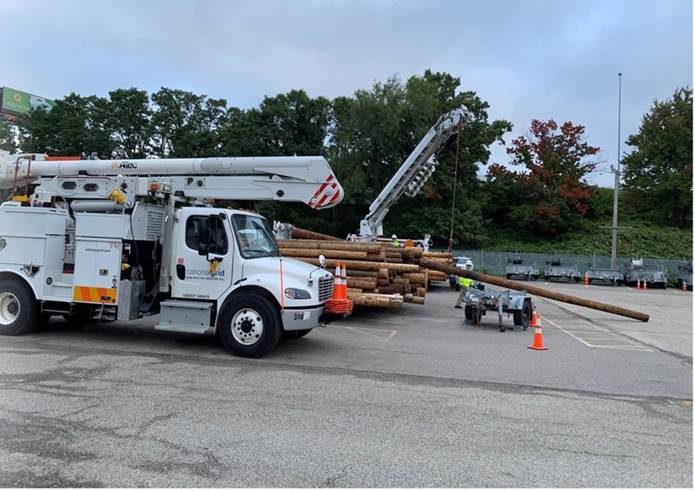Community
Elsa expected to become a Post-tropical Cyclone as National Grid gets ready, offers tips

An update has been issued on Elsa as National Grid gets ready for potential outages.
According to MEMA, at 5 PM, Tropical Storm Elsa was located 300 miles southwest of Atlantic City, New Jersey with maximum sustained winds of 50 mph and a minimum central pressure of 1006 mb. Elsa is moving toward the northeast near 21 mph. On the forecast track, Elsa will pass near the eastern mid-Atlantic states by tonight and is expected to pass near or over southeast New England on Friday as a tropical storm. No significant change in strength is expected through Friday, and Elsa is forecast to become a Post-tropical Cyclone by Friday night.
Additionally, there will be a risk of some scattered strong to severe storms behind the system, Friday evening.
Elsa is expected to be a fast-moving storm clearing out of MA by early Friday evening.
Impacts/ Potential Impacts
o Damaging winds (gusting 40 to 60 mph) and power outages. The greatest area of risk is mainly on Cape Cod and the Islands.
o Heavy rainfall of 2 to 4 inches with isolated totals up to 6 inches. The greatest area of impact will be north/west of Elsa’s track.
o Heavy rainfall could lead to isolated flash flooding and urban flooding.
o Potential for tornadoes Friday morning into the afternoon.
o Potential for dangerous marine conditions along with rough surf and rip currents along south coastal beaches.
Wind Threat and Potential Impact:
o The winds will start to ramp up after 5 AM Friday with the strongest winds starting around 8AM and peaking around 12:00 PM.
o Potential for 40 to 60 mph gusts on Cape Cod and the Islands.
o The risk for power outages is highest along the south coast, including Cape Cod and the Islands due to damaging winds.
o There is a lower risk of wind damage and power outages from the Providence to Boston corridor
The earliest reasonable time of arrival of tropical storm force winds would be Friday morning. Period of strongest winds will only be about 8 hours.
Elsa could produce 2-4 inches of rain, with isolated amounts up to 6 inches are possible. Locally, most rain will occur Friday morning.
The main threat of tornadoes would be Friday morning into Friday afternoon. There will be a risk of some scattered strong to severe storms behind the system, Friday evening.
National Grid is preparing for Tropical Storm Elsa to strike New England tomorrow morning and bring heavy rains and strong winds into the region for much of the day.
“As always, we’re monitoring the forecasts closely and we have more than 1,800 personnel in place across Rhode Island and Massachusetts to respond as quickly and safely as we can,” said Michael McCallan, Vice President of New England Electric Operations.
National Grid is preparing for this storm by securing 1,820 field-based personnel as part of our emergency response operations. This includes overhead line, forestry, contractors, underground, damage assessment, wires down, transmission, and substation workers.
The company has been preparing for the storm for several days, and is continuing to monitor the weather, communicating with local officials, first responders, and life support customers.
The Company offers the following tips and reminders:
Customers Should Stay Connected:
· Report power outages at www.nationalgridus.com or call 1-800-465-1212.
· Use your mobile device to track outage information and storm-related safety tips through National Grid’s mobile site accessible at www.ngrid.com/mobile.
· Like us on Facebook and follow us on Twitter and Instagram; we post all the latest storm and restoration updates.
· Track outages and estimated restoration times at www.nationalgridus.com/outage-central
· To stay connected during storms and outages, text to 64743 using any of the below commands.
o REG to sign up for text alerts
o OUT to report an outage
o SUM followed by your town, county, or state to get a summary of outages in your area
o HELP for the full list of commands
Stay safe:
· Never touch downed power lines, and always assume that any fallen lines are live electric wires. If you see one, report it immediately to National Grid or your local emergency response organization.
· Power problems can sometimes interrupt public water supply systems or disable well pumps, so it’s an especially good idea to keep a supply of bottled drinking water handy, as well as some canned food.
· People who depend on electric-powered life support equipment, such as a respirator, should let National Grid know. To register as a life support customer, call the company’s Customer Service Center at 1-800-322-3223.
· Check on elderly family members, neighbors and others who may need assistance during an outage period.
Electric safety:
· If you use a generator to supply power during an outage, be sure to operate it outdoors. Before operating generators, disconnect from National Grid’s system by shutting off the main breaker located in the electric service panel. Failure to do this could jeopardize the safety of line crews and the public.
· If you lose power, turn off any appliances that were on when the power went off, but leave one light on so you will know when power is restored.
· Reminder: It’s not safe to work in an elevated bucket during periods of increased wind gusts. Our line workers begin restoration work only when conditions are deemed safe.





You must be logged in to post a comment Login